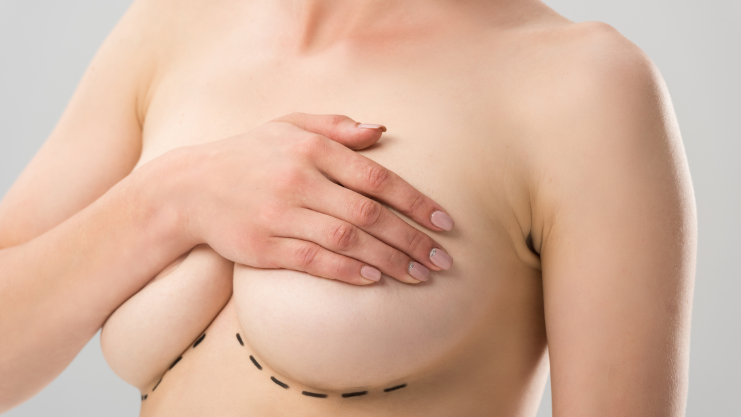
A breast lift with areola reduction is a procedure that improves the shape of the breast while adjusting the size of the areola to create a more balanced and natural look. This type of surgery combines two techniques for treating breast sagging and excessive areola size in a single procedure.
The surgery not only lifts and firms the breasts, but it can also correct the asymmetry and size of the areoles, helping to make the final result look harmonious. In addition, the recovery process is often manageable and allows people to return to normal activities within weeks.
This procedure is an option for those seeking to comprehensively improve the appearance of their breasts, combining aesthetic and functional benefits in a single treatment. Being well informed ensures that you understand what to expect before, during and after surgery, as well as the care needed for a good recovery.
The breast lift and the rollback Areola procedures are procedures that require precision to obtain a natural and harmonious result. Different techniques are used depending on the specific needs and the shape of the breasts. In addition, the preparation and type of anesthesia play a key role in patient safety and comfort.
The surgery begins with preoperative marking, where Dr. Ceballos points out the new position of the nipple and the areas of skin resection. An incision is made, which can be periareolar, vertical or anchor-shaped, depending on the degree of ptosis and breast volume.
The excess skin is then removed and the mammary gland is repositioned to lift the breast. The areola is brought to its natural location while maintaining sensitivity and vascularization. Finally, the incisions are closed with absorbable sutures to minimize visible scarring.
Areola reduction is an outpatient procedure that reduces the diameter of large or uneven areoles. The most common technique is circular resection around the areola to reduce its size without compromising nipple sensitivity or the ability to breastfeed.
Dr. Ceballos can vary the amount of tissue he removes depending on the desired proportion and symmetry with the other areola. Sometimes, it is combined with mastopexy to create a more balanced and aesthetic result in the breast.
The procedure can be performed under general anesthesia or with intravenous sedation together with local anesthesia, depending on the case and preference of the surgeon and patient. General anesthesia ensures greater comfort when the surgery is more extensive.
Before surgery, the patient must undergo a complete medical evaluation that includes a medical history, complementary tests and explanations about post-operative care. Prior fasting and avoiding certain medications that may increase bleeding risks are requested.
Asymmetric areoles are very common and can be corrected during surgery by selective reduction or increase in size and shape. Dr. Ceballos carefully measures both areoles before and during surgery to make them as even as possible.
In complex cases, customized techniques can be used that include tissue transplants or adjustments to the areolar contour. Maintaining nipple sensitivity and function is a priority in these corrections to preserve functional and aesthetic quality.
After a breast lift with areola reduction, the patient can expect noticeable improvements in the shape, firmness and proportion of the bust. Recovery follows an orderly process where pain control, infection prevention and medical follow-up are vital to ensure a good long-term outcome.
The recovery time is usually 2 to 3 weeks, during which intense physical activity should be avoided. The patient may experience swelling, moderate pain and tenderness in the treated area. It is recommended to keep the bust elevated and to wear a post-surgical bra to promote healing and repositioning.
Most people can resume light social and work activities after a week, although intense exercise and sudden movements should wait at least a month. Regular medical check-ups are key to ensuring that the recovery is taking its course properly.
Breast lift and areola reduction incisions usually leave small, well-located scars that are barely visible. Over time, these scars soften and lighten, although they don't completely disappear.
Final aesthetic results usually stabilize 3 to 6 months after surgery. The combination of both techniques gives a natural and harmonious contour, improving both the shape and size of the areola without affecting the sensitivity of the nipple. Complications are rare if the patient follows medical advice.
It is essential to keep the wound clean and dry to prevent infection. The patient should avoid exposing the area to direct sunlight for at least 3 months to avoid dark spots and scars.
It is advisable to follow the indicated medication regimen, including analgesics and antibiotics if prescribed. The use of the special bra must be respected for as long as recommended. It is also important to avoid smoking and to eat a balanced diet that helps healing.
Monitoring appointments with Dr. Ceballos ensure the early detection of any problems and confirm that the results are progressing properly.
The surgery reduces the size of the areola and improves the shape to make it look more proportionate. The chest generally looks younger and more balanced after mastopexy combined with reduction. There is an improvement in symmetry between both breasts.
The surgery lasts between one and two hours and is usually outpatient. In the first week, swelling and some mild pain are common. It is recommended to wear supportive clothing and avoid strenuous exercise for at least two weeks.
The scars are usually circular around the areola. Over time, scars may become less visible if properly cared for. The use of special creams and avoiding exposure to the sun helps with healing.
The results can last for several years if significant weight gain or loss is avoided. Factors such as natural aging and hormonal changes can affect appearance over time.